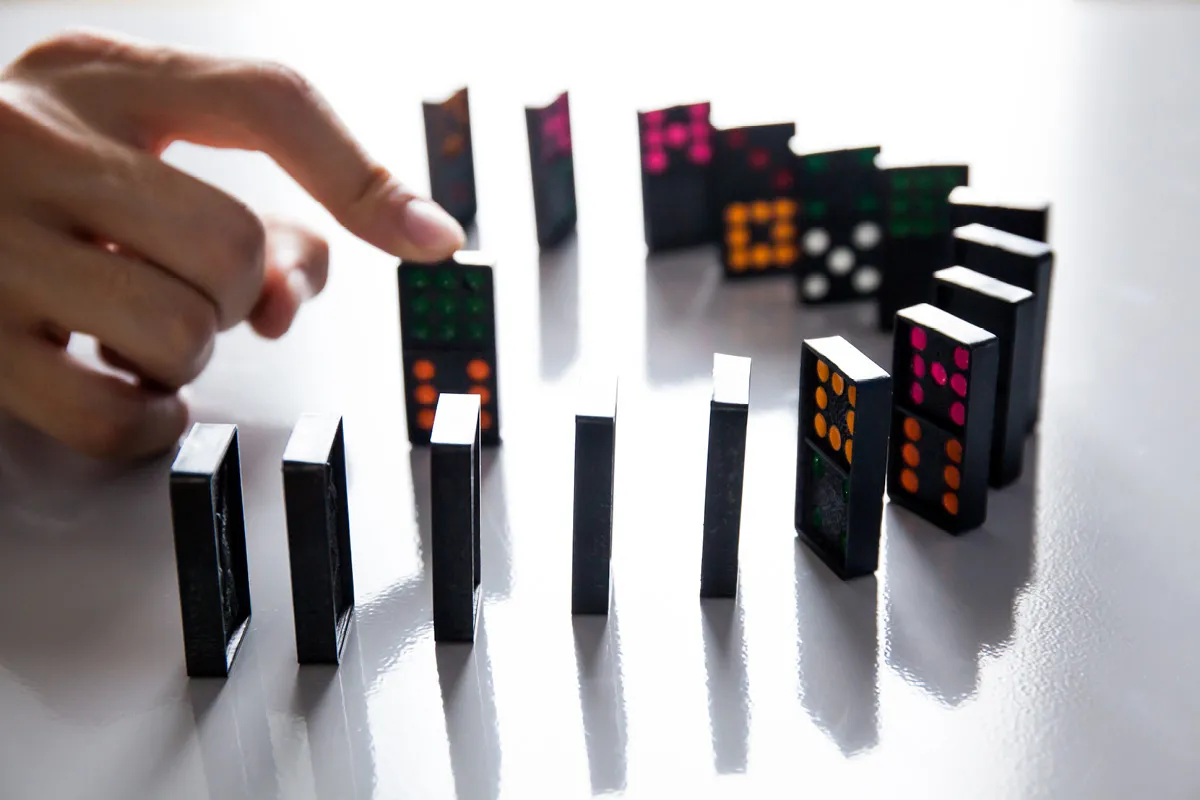Many companies fail to achieve their ambitious up- and cross-selling goals for their products or services. However, the targeted use of behavioral science can help reverse this situation.
What is gamification?
Gamification is the application of game-design elements and principles in non-game contexts. The aim is to engage and motivate people to achieve certain goals. It incorporates elements such as points, badges, leaderboards, and challenges to make tasks more interactive and enjoyable. Ultimately, gamification drives desired behaviors or outcomes.
How can gamification help with cross-selling?
Industry leaders such as Apple demonstrate just how much potential companies can unleash with the right cross-selling strategy. MacBook, iPhone, iPad, Apple Watch – every Apple product has become a status symbol.
However, unlike the Silicon Valley giant, many regular companies are failing to reach their ambitious cross-selling goals. This prevents them from becoming the “Apple” of their industry. Clearly, many are leaving significant profit and sales potential on the table.
Gamification can help companies with cross-selling by incorporating game-design elements and principles. This engages and motivates customers to explore and purchase more products or services. It also makes the cross-selling process more interactive and enjoyable for customers. This approach can drive desired behaviors, increase customer engagement, and ultimately boost up- and cross-selling rates considerably.
Here are several ways gamification can help with cross-selling:
- Incentivizing exploration. Gamification can motivate users to explore different product categories or offerings within a platform.
- Rewarding cross-purchases: Offering rewards, points, or badges for purchasing complementary products can encourage users to consider additional items that complement their initial purchase.
- Creating product bundles. Gamification can involve creating themed bundles of products and offering discounts or special rewards for purchasing the entire set.
- Personalized recommendations. Utilizing gamified recommendation engines that analyze user behavior and preferences can suggest cross-sell opportunities based on past purchases or browsing history. This increases the relevance and effectiveness of cross-selling efforts.
- Limited-time offers and challenges. Time-limited challenges or promotions incentivize users to make cross-purchases within a specific timeframe, creating a sense of urgency and driving immediate action.
- Progressive disclosure. Gradually introducing users to complementary products or services as users engage with the initial product encourages further exploration.
- Interactive product demos or trials. Allowing users to experience the benefits of products firsthand increases the likelihood of a cross-purchase.
Most companies only use “push” marketing techniques, i.e. they simply suggest products to customers. In contrast, “pull” marketing provides customers with an incentive to browse the company's entire range of products and services. However, many companies overlook this approach.
With a few simple measures, you can steer your customers’ behavior in the right direction, considerably boosting your up- and cross-selling rates.
Examples of sales gamification
To understand how behavioral economics increases cross-selling rates, we can gain important insights from the world of play. The key idea here is the “gamification” of the product offering.
Video game developers have known for a long time that these effects actually make their games more addictive. The most successful game designs often tap into people's innate urge to want to complete their “collections.”
One famous example is the search for “hidden packages” in the hit game series Grand Theft Auto. Players have to search through the entire game to find these randomly placed objects.
The advantages for finding these items actually aren’t worth the effort. It's simply the fun of retrieving “collectibles” that makes the package search a popular part of the game. In addition, players’ desire for status is also vital to increasing the attractiveness and profitability of video games.
The phenomenon of “in-game purchases” (IGP) has become increasingly important over the last few years. It shows that these effects don’t just enhance the gaming experience. They are also very lucrative for developers.
After purchasing a game, players can buy additional game elements via IGPs. These can include extended versions of the game map or extra “skill points” to increase the players’ strength. Status-symbol features, such as new playable characters or special clothing, are also available to buy. According to a study by the University of Tampere, the desire to unlock all elements of a game is one of the top three reasons for making in-game purchases.
Do customers value gamification?
Customers often appreciate gamification when it enhances their experience in a meaningful way. Gamification can make tasks more engaging, motivating, and enjoyable. It can also foster a sense of achievement and progression, which can be appealing to customers.
However, the success of gamification depends on various factors such as the target audience, the nature of the product or service, and how well the gamification elements are implemented. When done thoughtfully and aligned with customer preferences, gamification can add significant value and increase customer satisfaction and loyalty.
In particular, customers value:
- Engagement. Gamification makes experiences more interactive and engaging, capturing users' attention and motivating them to participate actively.
- Reward systems. The sense of progress and achievement through rewards, points, badges, or levels encourages customers to continue engaging with a product or service.
- Competition and social interaction. Competitive elements such as leaderboards and challenges create a sense of friendly competition among users, fostering social interaction and community building.
- Entertainment value. Incorporating game-like elements adds an element of fun and entertainment to otherwise mundane tasks, making the overall experience more enjoyable.
- Motivation and behavior change. Gamification can incentivize positive behaviors such as better financial health or more sustainable consumption by providing rewards and recognition for achieving goals.
- Personalization. Tailoring the gamified experience to individual preferences and behaviors enhances its relevance and effectiveness, making customers feel valued and understood.
Can we use game mechanics in other industries?
The answer is a resounding yes. The banking sector is leading the way with applying game elements to sales approaches.
For example, Simon-Kucher developed the “Home-bank Program,” incorporating several gamification elements. This program divides bank products into logical product areas and is presented as a unified system. Customers who use products from multiple regions receive a loyalty bonus. Implementing this approach can increase cross-selling by 25 percent in the first year.
Customers reacted very positively to the introduction of this program, despite a simultaneous price increase of up to 30 percent on checking accounts. In addition to increased customer loyalty, churn rates due to the price increase fell to near zero..
Gamification even offers promising applications for industrial companies in the B2B sector. Its uses range from enhancing conventional product sales like components and replacement parts (e.g. “spare part kits”), to facilitating the increasingly important business area of solution-selling (e.g. add-on digital services and other options sold with the main product).
The targeted application of behavioral economic theory, such as gamification, is more than just a “nice to have.” In the future, these insights will form an essential part of any successful sales strategy. This is even more important if you use a digital sales channel (e.g. an online shop).
Even in the B2B sector, most decisions are still made by people. These decisions are therefore based on human behaviors that are often subconscious.
Where sales gamification can go wrong
Gamification, when implemented incorrectly, can lead to several pitfalls.
- Focusing too much on the game elements themselves rather than aligning them with your company's overall objectives. If the gamification strategy lacks a clear purpose or relevance to your business goals, it can result in disengagement from both customers and employees.
- Excessive gamification without a proper understanding of the target audience can lead to alienation and frustration.
- Over-reliance on extrinsic rewards, such as badges or points. This may overshadow intrinsic motivation and diminish long-term engagement.
- Poorly designed gamification mechanics that are overly complex or confusing can deter users from participating. This defeats the purpose of enhancing motivation and driving desired behaviors.
Moreover, companies should make sure they don’t overlook internal hurdles, such as:
- Sales employees feeling uncomfortable about selling via “push” methods
- Gamification being seen as something negative
- Sales reps not reaching out to the “right” customers
- Sales team not being informed about current developments
It is crucial to carefully plan and execute gamification strategies to avoid these potential pitfalls and ensure successful implementation. Our experts at Simon-Kucher provide a solid understanding of behavioral economics, human behavior, and motivation. We apply this knowledge to design gamified systems that work for our clients, including testing to ensure gamification efforts do not backfire.
How Simon-Kucher can help with your gamification strategy
Simon-Kucher can help your business develop an effective gamification strategy. By integrating gamification elements into your sales initiatives, we help you motivate and engage customers while achieving your strategic objectives.
Our gamification techniques are always tailored to suit your organization's unique needs and preferences. This might involve customizing game contexts, rewards, and feedback mechanisms to align with sales objectives and customer dynamics.
We design game contexts that mimic real-world scenarios relevant to your customers' buying experience. We incorporate familiar elements from video gaming, such as earning points, leveling up, and progressing through challenges.
From gamified sales contests where customers compete to achieve specific targets or milestones, to gamification techniques such as progress bars, leaderboards, and rewards, we help our clients encourage desirable behaviors.
Whether you are looking to better meet your sales quotas, prospect new customers, or improve customer satisfaction, Simon-Kucher is here to help. Reach out to our experts today.



